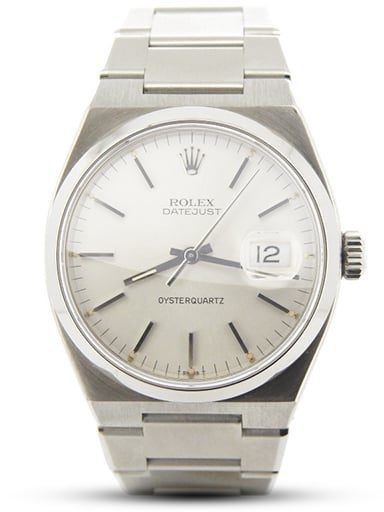Rolex began their own research into electronic timekeeping in the early 1950s well before the ‘Quarts crisis’ of the 1970s, and was awarded their first patent for an electro-mechanical watch design in 1952. According to The Best of Time, by James Dowling, of the 50 patents issued to Rolex between 1960 and 1990, 21 of them were for electronic watches.

The First Quartz
Rolex’s first commercially available quartz watch was the Quartz Date 5100. Introduced in 1970, this watch shared the Beta 21 movement, developed by Rolex and 20 other Swiss brands. It was also used by other Swiss companies like Omega and Enicar. A total of 16 different Swiss watch companies sold their own branded watches with the Beta 21 quartz unit inside. Rolex only produced 1000 of these watches before beginning development of their own quartz movement and the watch that would eventually become the Oysterquartz. In 1977, after five years of design, development, and testing, Rolex introduced their first completely in-house quartz movements (the 5035 and 5055) and the Datejust (5035) and Day-Date (5055) Oysterquartz models that would house them.
The Standout Features
When they were introduced, the 5035 and 5055 quartz modules were marvels of technology as well as fit and finish. These 11 jewel movements utilized the latest CMOS circuitry, a 32khz oscillator, and analog thermo-compensation. In addition, they were finished to even higher standards than Rolex’s mechanical movements, this is especially true when you see one. The stand out feature of both the 5035 and 5055 quartz movements is the inclusion of Geneva stripes, normally only found on top end mechanical movements. No other quartz movement is comparable in terms of finishing and beauty.

Datejust Models
For 25 years Rolex produced the Oysterquartz in Datejust models (17000 stainless steel, 17013 steel and yellow gold, 17014 steel and white gold), and Day-Date models in all gold (19018yellow gold, 19019 white gold). Special models of the Oysterquartz were also produced with jewelled dials, bezels, and bracelets.
Produced Until 2001
It has been estimated that there were less than 25,000 Oysterquartz watches ever produced. The last year the Reference 17000 appeared in the Rolex catalogue was 2001, and this was also the last year Rolex received any chronometer certificates for quartz movements from the COSC. This means 2001 was likely the last year any Oysterquartz watches were actually produced. The steel and gold dual tone and all gold models continued in the Rolex catalogue until 2003 when the stock of these models was finally depleted.
The Mystery Rolex Oysterquartz
There is clear and convincing evidence that by the time production of the 5035 and 5055 movements ceased in 2001 Rolex had two completely new quartz movements ready for use in a new generation of Oysterquartz Datejust and Day-Date watches. These movements (the 5335 and 5355) had 23 jewels and featured a perpetual calendar. This came to a fore because a mystery Rolex Oysterquartz with no reference designation appeared at auction by Antiquorum featuring one of the new 5335 quartz movements inside. For reasons known only to Rolex the decision was made not to put these new movements into production and the Oysterquartz line was finally dropped when the last watches had been shipped from Rolex in Geneva in 2003.
Rolex Oysterquartz Milestones
| 1950s | Rolex begins research into electronic timepieces. |
| 1952 | Rolex is awarded their first patent for electro-mechanical watch design. |
| 1970 | Reference 5100 is released with the Beta 21 calibre powering it. Designed in conjunction with 20 other Swiss watch brands, the Beta 21 ended up inside numerous other watches. |
| 1977 | After 5 years of development and design, Rolex release their first in-house quartz movements, the 5035 and 5055. |
| 2001 | Oysterquartz movements no longer awarded COSC certificates, more than likely this was the year that no more were being submitted for certification. |
| 2003 | The last of the Oysterquartz models is sold and shipped. |
| 2004 | An unmarked Rolex Oysterquartz appears at auction by Antiquorum, powered by a 5335 movement. It employs a perpetual calendar mechanism. The future of the oysterquartz? |



